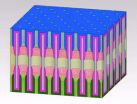(Press-News.org) This news release is available in French.
The motor neurons that innervate muscle fibres are essential for motor activity. Their degeneration in many diseases causes paralysis and often death among patients. Researchers at the Institute for Stem Cell Therapy and Exploration of Monogenic Diseases (I-Stem - Inserm/AFM/UEVE), in collaboration with CNRS and Paris Descartes University, have recently developed a new approach to better control the differentiation of human pluripotent stem cells, and thus produce different populations of motor neurons from these cells in only 14 days. This discovery, published in Nature Biotechnology, will make it possible to expand the production process for these neurons, leading to more rapid progress in understanding diseases of the motor system, such as infantile spinal amyotrophy or amyotrophic lateral sclerosis (ALS).
Human pluripotent stem cells have the ability to give rise to every cell in the body. To understand and control their potential for differentiation in vitro is to offer unprecedented opportunities for regenerative medicine and for advancing the study of physiopathological mechanisms and the quest for therapeutic strategies. However, the development and realisation of these clinical applications is often limited by the inability to obtain specialised cells such as motor neurons from human pluripotent stem cells in an efficient and targeted manner. This inefficiency is partly due to a poor understanding of the molecular mechanisms controlling the differentiation of these cells.
Inserm researchers at the Institute for Stem Cell Therapy and Exploration of Monogenic Diseases (I-Stem - Inserm/French Muscular Dystrophy Association [AFM]/University of Évry Val d'Essonne [UEVE]), in collaboration with CNRS and Paris-Descartes University, have developed an innovative approach to study the differentiation of human stem cells and thus produce many types of cells in an optimal manner.
"The targeted differentiation of human pluripotent stem cells is often a long and rather inefficient process. This is the case when obtaining motor neurons, although these are affected in many diseases. Today, we obtain these neurons with our approach in only 14 days, nearly twice as fast as before, and with a homogeneity rarely achieved," explains Cécile Martinat, an Inserm Research Fellow at I-Stem.
To achieve this result, the researchers studied the interactions between some molecules that control embryonic development. These studies have made it possible to both better understand the mechanisms governing the generation of these neurons during development, and develop an optimal "recipe" for producing them efficiently and rapidly.
"We are now able to produce and hence study different populations of neurons affected to various degrees in diseases that cause the degeneration of motor neurons. We plan to study why some neurons are affected and why others are preserved," adds Stéphane Nedelec, an Inserm researcher in Cécile Martinat's team.
In the medium term, the approach should contribute to the development of treatments for paralytic diseases such as infantile spinal muscular amyotrophy or amyotrophic lateral sclerosis. "Rapid access to large quantities of neurons will be useful for testing a significant number of pharmacological drugs in order to identify those capable of preventing the death of motor neurons," concludes Cécile Martinat.
INFORMATION:
These results are the subject of a patent application with Inserm Transfert.
*Sources*
Combinatorial analysis of developmental cues efficiently converts human pluripotent stem cells into multiple neuronal subtypes
Abbreviated title: Systematic hPSC conversion into neuronal subtypes
Yves Maury1, Julien Côme1, Rebecca A. Piskorowski2, Nouzha Salah-Mohellibi3, Vivien Chevaleyre2, Marc Peschanski3, Cécile Martinat3 and Stéphane Nedelec3
1 CECS, I-STEM (Institute for Stem Cell Therapy and Exploration of Monogenic Diseases), AFM, Evry, France
2 CNRS UMR 8118, Université Paris Descartes Sorbonne Paris Cité, Paris, France.
3 INSERM/UEVE UMR 861, I-STEM, AFM, Evry, France
Nature Biotechnology, 17 novembre 2014
DOI: 10.1038/nbt.3049
*Contact chercheur*
Cécile Martinat
Inserm researcher
Inserm Unit 861 "INSTITUT FOR STEM CELL THERAPY AND EXPLORATION OF MONOGENIC DISEASES (I-STEM)" (Inserm / UEVE, AFM)
Génopôle Campus 1 - 5 rue Henri Desbruères 91030 Evry cedex
CMARTINAT@istem.fr
+33 1 69 90 85 33 / +33 6 03 85 54 77
Stéphane Nedelec
Inserm researcher
Inserm Unit 861 "INSTITUT FOR STEM CELL THERAPY AND EXPLORATION OF MONOGENIC DISEASES (I-STEM)" (Inserm / UEVE, AFM)
Génopôle Campus 1 - 5 rue Henri Desbruères 91030 Evry cedex
snedelec@istem.fr
+33 1 69 90 85 26
*Press contact*
Inserm - Juliette Hardy
presse@inserm.fr
AUSTIN, Texas -- Researchers at the Cockrell School of Engineering at The University of Texas at Austin have achieved a milestone in modern wireless and cellular telecommunications, creating a radically smaller, more efficient radio wave circulator that could be used in cellphones and other wireless devices, as reported in the latest issue of Nature Physics.
The new circulator has the potential to double the useful bandwidth in wireless communications by enabling full-duplex functionality, meaning devices can transmit and receive signals on the same frequency band at ...
Researchers from the Norwegian University of Science and Technology (NTNU) and the University of Cambridge in the UK have demonstrated that it is possible to directly generate an electric current in a magnetic material by rotating its magnetization.
The findings reveal a novel link between magnetism and electricity, and may have applications in electronics.
The electric current generation demonstrated by the researchers is called charge pumping. Charge pumping provides a source of very high frequency alternating electric currents, and its magnitude and external magnetic ...
LA JOLLA, CA--November 10, 2014--Chemists at The Scripps Research Institute (TSRI) and the Shanghai Institute of Organic Chemistry have described a method for creating and modifying organic compounds that overcomes a major limitation of previous methods. The advance opens up a large number of novel chemical structures for synthesis and evaluation, for example, as candidate pharmaceuticals.
The new method was designed to avoid an unwanted side effect--a diversion of a catalyst molecule to the wrong location--that prevents chemists from manipulating many organic compounds ...
The Southern Ocean plays an important role in the exchange of carbon dioxide between the atmosphere and the ocean. One aspect of this is the growth of phytoplankton, which acts as a natural sponge for carbon dioxide, drawing the troublesome greenhouse gas from the atmosphere into the sea. When these plankton die they can sink to the bottom of the ocean and store some of the carbon dioxide they have absorbed, a process scientists call the "biological carbon pump".
Although many areas of the Southern Ocean are rich in nutrients, they often lack iron, which limits phytoplankton ...
Cold Spring Harbor, NY - Think about all the things you are doing at this moment. As your eyes scan across the lines of this article, maybe your brain is processing the smell of coffee brewing down the hall and the sound of leaf blowers outside your window. Maybe you are tapping your foot and spinning a pen between your fingers. At any given moment, your brain is simultaneously processing a multitude of information from your senses while supporting a dizzying array of behaviors.
How is all this information processed at once? The provisional answer, for decades, has centered ...
COLLEGE PARK, Md. -- Researchers at the University of Maryland have invented a single tiny structure that includes all the components of a battery that they say could bring about the ultimate miniaturization of energy storage components.
The structure is called a nanopore: a tiny hole in a ceramic sheet that holds electrolyte to carry the electrical charge between nanotube electrodes at either end. The existing device is a test, but the bitsy battery performs well. First author Chanyuan Liu, a graduate student in materials science & engineering, says that it can be ...
OAK RIDGE, Tenn., Nov. 10, 2014--For more than 50 years, scientists have debated what turns particular oxide insulators, in which electrons barely move, into metals, in which electrons flow freely. Some scientists sided with Nobel Prize-winning physicist Nevill Mott in thinking direct interactions between electrons were the key. Others believed, as did physicist Rudolf Peierls, that atomic vibrations and distortions trumped all. Now, a team led by the Department of Energy's Oak Ridge National Laboratory has made an important advancement in understanding a classic transition-metal ...
Cold Spring Harbor, NY - There are roughly 20,000 genes and thousands of other regulatory "elements" stored within the three billion letters of the human genome. Genes encode information that is used to create proteins, while other genomic elements help regulate the activation of genes, among other tasks. Somehow all of this coded information within our DNA needs to be read by complex molecular machinery and transcribed into messages that can be used by our cells.
Usually, reading a gene is thought to be a lot like reading a sentence. The reading machinery is guided ...
Thousands of never-before-seen genetic variants in the human genome have been uncovered using a new genome sequencing technology. These discoveries close many human genome mapping gaps that have long resisted sequencing.
The technique, called single-molecule, real-time DNA sequencing (SMRT), may now make it possible for researchers to identify potential genetic mutations behind many conditions whose genetic causes have long eluded scientists, said Evan Eichler, professor of genome sciences at the University of Washington, who led the team that conducted the study.
"We ...
UCLA neuroscientists discovered that statins, a popular class of cholesterol drugs, reverse the learning deficits caused by a mutation linked to a common genetic cause of learning disabilities. Published in the Nov. 10 advance online edition of Nature Neuroscience, the findings were studied in mice genetically engineered to develop the disease, called Noonan syndrome.
The disorder can disrupt a child's development in many ways, often causing unusual facial features, short stature, heart defects and developmental delays. No treatment is currently available.
"Noonan ...







